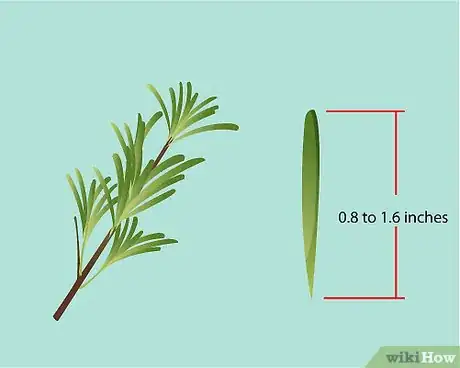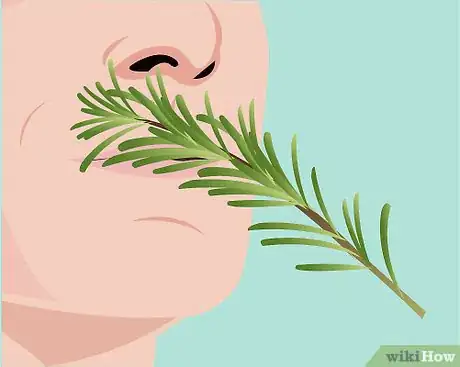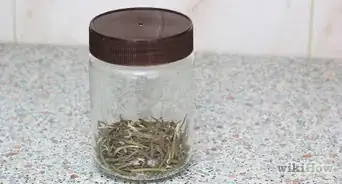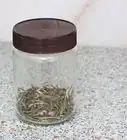wikiHow is a “wiki,” similar to Wikipedia, which means that many of our articles are co-written by multiple authors. To create this article, 12 people, some anonymous, worked to edit and improve it over time.
There are 11 references cited in this article, which can be found at the bottom of the page.
This article has been viewed 124,597 times.
Learn more...
Rosemary (Rosmarinus officinalis) is a shrub that is native to Asia and the Middle East. This herb does well in a Mediterranean climate due to the fact that it can survive both floods and drought. Certain varieties of rosemary are native to parts of the United States as well. The stems and needles of the rosemary plant are used primarily for cooking fish or meats and as a spice for savory dishes. Other uses include medicinal and decorative. Sometimes rosemary plants are trimmed to resemble Christmas trees or are cut into other shapes to use in landscaping. Learn how to identify rosemary at the local garden shop or perhaps the one growing naturally in your backyard.
Steps
-
1Measure the rosemary. Upright forms of rosemary can grow to 5 feet (1.5 m) in height.[1] There are trailing forms of rosemary as well which grow low and spread on the ground.
-
2Look for plants that resembles a short pine tree with a fat trunk and smaller, long, thin branches which grow straight up into the air from the trunk. However, the lower branches tend to droop to the ground unless they are pruned.Advertisement
-
3Look for stems which are woody and have a scaly gray bark.
-
4Measure the needles of the plants. Their lengths vary from 0.8 to 1.6 inches (2 to 4 cm) long.
-
5Check that the long, thin needles start forming about a quarter of the way up from the base of the branch and grow densely, pointing upwards.
-
6Look for needles that are dark greenish gray in color with a vein in the center of each needle. Healthy rosemary needles remain green all year.
-
7Look at the bottom of the needles for the silver color underneath.[2] Check that the edges curl downwards. The undersides of the needles are somewhat fuzzy to the touch.
-
8Smell the foliage. Rosemary has a woodsy pungent aroma. Some think it has tones of pine and lemon.[3] A hint of camphor might be detected. There is a resinous quality to the fragrance which is quite distinctive and remains on your hands when you pull the needles from the stem.
-
9Look for white, blue, pink or purple flowers in clusters at the tips of the branches.[4] Most rosemary blooms in the summer in mild climates, but plants growing where the winters are warm may bloom year round.
-
10Attempt to identify fresh rosemary in the store. Look for stems, sometimes still attached to the roots, where the needles are green and have a strong aroma, which indicate freshness.[5]
Community Q&A
-
QuestionWhere can it be found in a forest?
 Community AnswerIt looks much like it does in the store, spiky and tall, it is easiest to identify based on its smell.
Community AnswerIt looks much like it does in the store, spiky and tall, it is easiest to identify based on its smell. -
QuestionWhat does rosemary smell like?
 Community AnswerRosemary smells very similar to pine.
Community AnswerRosemary smells very similar to pine. -
QuestionWill rosemary attract bees or deer?
 Community AnswerIt will entice bees, but it shouldn't entice deer.
Community AnswerIt will entice bees, but it shouldn't entice deer.
References
- ↑ https://www.almanac.com/plant/rosemary
- ↑ http://www.whfoods.com/genpage.php?tname=foodspice&dbid=75
- ↑ https://www.reference.com/food/rosemary-smell-like-8135e9a0568a0f7b
- ↑ http://sonomamg.ucanr.edu/Plant_of_the_Month/Rosemary/
- ↑ https://www.youtube.com/watch?v=dnqSjnXyQPs
- ↑ https://www.monrovia.com/plant-catalog/plants/596/arp-rosemary/
- ↑ http://www.missouribotanicalgarden.org/PlantFinder/PlantFinderDetails.aspx?taxonid=252551&isprofile=0&
- ↑ http://www.missouribotanicalgarden.org/PlantFinder/PlantFinderDetails.aspx?taxonid=263865
- ↑ https://www.rhs.org.uk/Plants/48075/Rosmarinus-officinalis-Severn-Sea/Details






























































